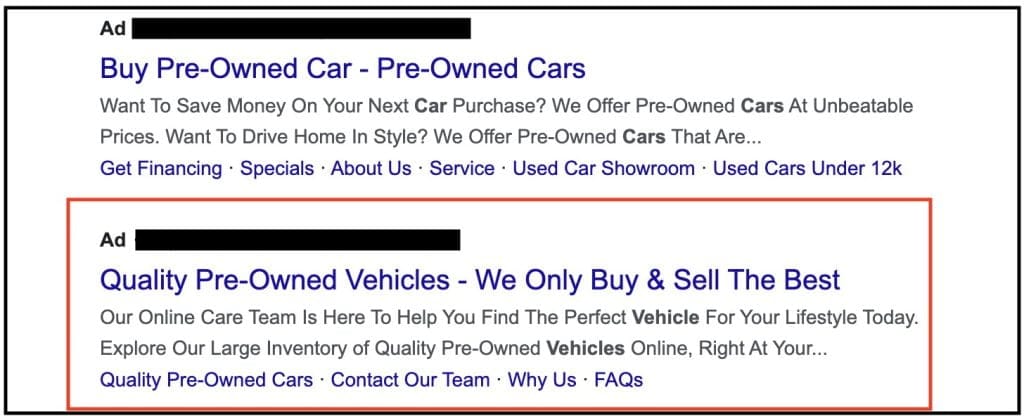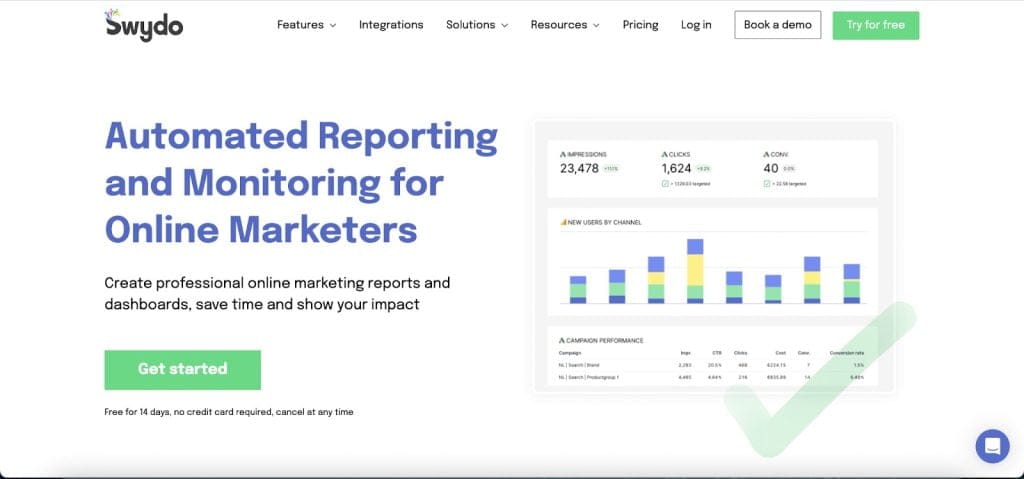With just a laptop and internet connection, the possibilities for starting a business in the digital age are endless. You could create a social media page, build an email marketing business, or even launch a website to generate revenue through ads, product promotion, and affiliate marketing. However, with the ease of entry comes increased competition, and it’s important for digital business owners to constantly adapt and optimize their sales strategies to survive.
That’s where conversion rate optimization (CRO) comes in. CRO is an essential part of any successful digital business, as it improves the conversion of almost all digital channels. Here are different conversion metrics with respect to channels that CRO can improve:
- Open rate and click-through rate (CTR) of emails designed for email marketing
- CTR for pay-per-click (PPC) campaigns (Paid campaigns)
- Engagement and followers on the social media page
- No. of visitors, visitor duration, revenue, etc, for the website
In this blog, we’ll explore the critical role that CRO plays in improving the conversion of paid search ads and websites. Join us as we delve deep into this topic and help you take your digital business to the next level.
Conversion Optimization for Paid Search Campaigns
Marketers employ various tactics to engage with potential customers and persuade them of a product or service’s worth. One such strategy is leveraging search engine optimization (SEO) to establish a brand’s authority and generate consistent organic traffic and conversion. However, this approach demands significant time and effort. Therefore, marketers also resort to paid marketing tactics like placing search ads to connect with highly targeted visitors and fulfill diverse marketing and revenue goals swiftly.
Search ads are a popular and preferred mode of paid advertisement placement. The projected ad spending on search advertisements is expected to reach US$296.70bn in 2023, which means more players entering the market and tight competition for every business. Thus, in a highly competitive market, marketers must experiment to optimize the paid search campaign to stay relevant to visitors and bring positive ROI from each ad.
One experiment by Search Engine Land is a great example of how even a minor optimization can create a significant difference. The company tested ad copy heading punctuation. The ad copy with an exclamation mark in the heading text outperformed in terms of CTR.

Image Source: Search Engine Land
But how to optimize search campaigns? If you ponder over this question, here is how you should move forward.
Techniques for Paid Campaign Conversion Testing
Paid campaign conversion testing involves creating hypotheses, setting campaigns, and campaign tracking. Here are each of the techniques in detail.
a. Creating a hypothesis
It is the brainstorming stage, where you first meet with all the stakeholders and decide on goals, campaign budget, timelines, and target audience. It is followed by setting up a benchmark on the KPI.
Next, you must work on the hypothesis and ideas for the variations that are based on observations and past behavior data. For example, you observed that the CTR is low for previous ad campaigns. This observation can lead to multiple hypotheses like poor ad copies, poor ad position, incorrect targeting/keywords, poor brand positioning, changing customer behavior, and so on.
It’s also important to break down each hypothesis further. For example, if poor ad copies are identified as a possible cause of low CTR, it could be due to poor language or a weak value proposition. By breaking down the hypothesis into components, you can create variations of ad copies that cater to each potential cause.
b. Setting up campaigns
The success of a paid search campaign lies in how you manage the account structure.
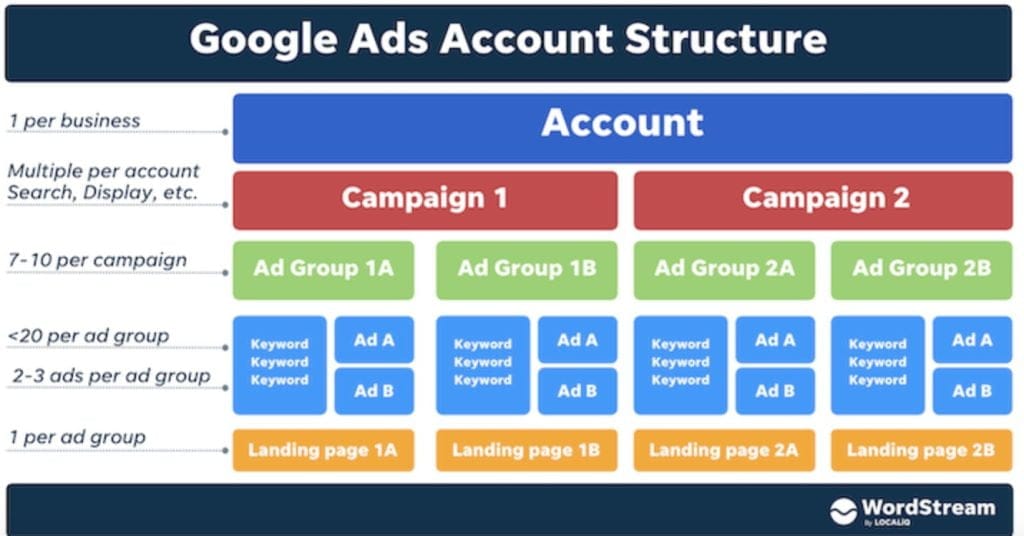
Search ads require creating campaigns based on macro and micro filters. For instance, if you’re running a search ad campaign for an e-commerce store, you can segment campaigns at the macro level using filters such as geography. This could involve creating campaigns that target different states or regions within the country. At the ad group level, you can apply filters like age group or gender to refine your targeting further. Ad copies can then be segmented based on micro filters like keyword match type.
For a typical B2B campaign, you can create a campaign based on multiple filters like geography, ad network, campaign theme, and end goal, and in that campaign, you can have ad groups with filters like sales funnel stage, campaign sub-theme, and keyword match type.
Once you have a robust account structure in place, the test campaign can be set up based on the elements like keywords, bidding strategy, and ad copy. With platforms like Google ads, you have the option to experiment with bidding, keywords, landing pages, audiences, and ad groups using custom experiments. The Ad variations option allows experimenting with headings, URL paths, descriptions, mobile URLs, etc. For deploying ad variations, you can select all campaigns or specific campaigns from the account.
c. Campaign tracking
Once everything is in place, you can start running the ad campaign with ad copy variations until you reach statistical significance or the end of the stipulated time frame. After concluding the test, you can deploy the winning ad copy variation and monitor its performance. If the winning ad copy produces the desired results, that’s great. If not, you can go back to the drawing board with a new hypothesis and test based on learnings from the failed test. By continuously testing and refining your search ads campaigns, you can optimize their performance over time and achieve better ROI.
You must repeat the process of creating hypotheses, setting up campaigns, and tracking campaigns to test-learn-improve with each iteration.
Actionable Tips to Optimize Search Ads Campaigns
You can make your search ads perform better with the following actionable tips:
a. Automate routine tasks
Automating routine tasks such as bid optimization, search term optimization, and keyword optimization can be highly beneficial for high-performing teams managing multi-million dollar budgets.
For instance, Aniruddh Jain, who heads performance marketing at VWO, has overseen a budget exceeding $30 million for more than 12 years in his career. He suggests that automation frees up time to strategize, save costs, and explore innovative approaches for future optimization initiatives. One strategy employed by his team involved setting criteria to automatically decrease bids for underperforming keywords, filtering out any keywords that exceeded a specific threshold (such as $10) without generating any conversions (<1 lead) in the previous week.
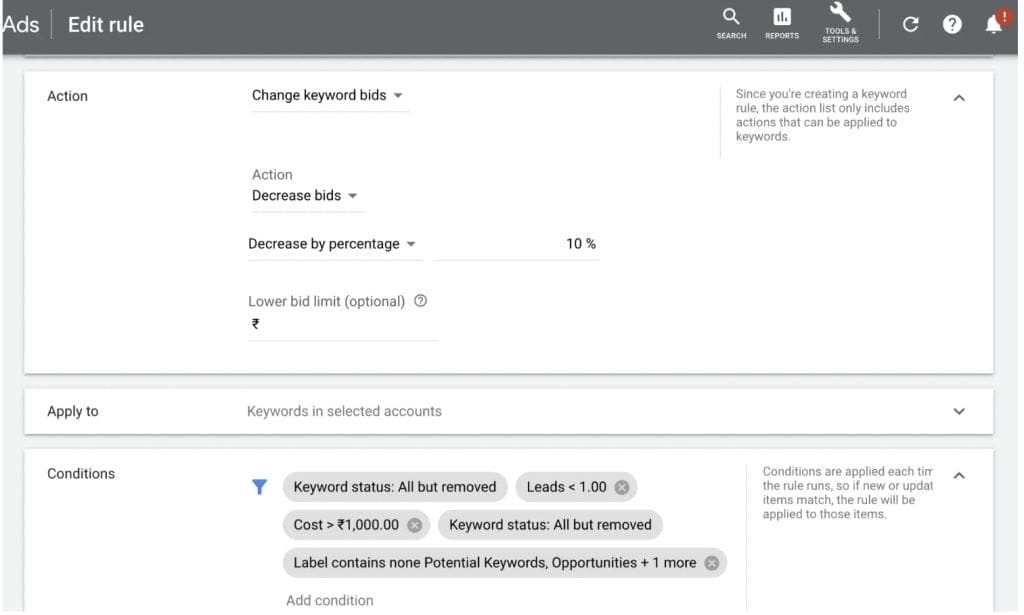
b. Talk with sales and customer success teams
The sales and customer success teams interact with clients daily and gather insights about their pain points, intent, and experience. By collaborating with these teams, you can gain a deeper understanding of the search queries and intent of clients. You can also analyze raw lead data to gain insights into the customer journey and identify areas for improvement.
Using these insights, you can develop campaign hypotheses for future optimization. By leveraging the knowledge and experience of your sales and customer success teams, you can create more effective ad campaigns that resonate with your target audience and drive better results.
c. Micro test search ads headline
You can experiment with headings and make minor changes to see the impact on the CTR. As the Search Engine Land study mentioned earlier demonstrates, even minor changes such as adding punctuation can have a significant impact on performance.
Another approach is to test benefit-driven headlines against generic keyword headlines to determine which type of messaging resonates more with users. The image showcases a benefit-driven headline in the red box and a generic headline above it.
By conducting these tests and analyzing the results, you can identify the most effective approaches for your ad campaigns and optimize your ad copy for maximum impact.
Conversion Optimization for Websites
Websites are now the primary platform for businesses to engage with customers and promote their products and services. With the ease of creating a website and selling products, one billion-plus websites are operating on different domains, competing for traffic, clicks, and conversion. The current conversion rate for websites like e-commerce stores stands at 2.5%.
Hence, conversion rate optimization is inevitable for any business to stay relevant in the market and maintain positive ROI. However, many companies struggle with CRO.
So here is how to get started.
Techniques for Website Conversion Testing
Before going forward with conversion testing, you must find out the baseline conversion for your website, which is the existing key metric’s conversion rate. The key metric depends on the sales funnel stage. Here are metrics as per the sales funnel stage.
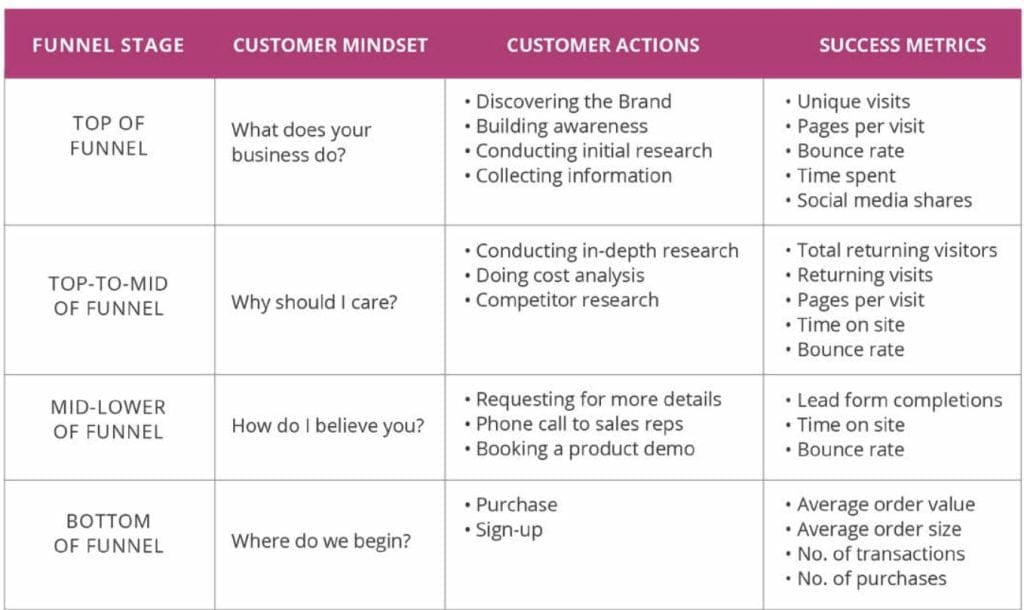
Image source: VWO
After knowing your baseline conversion, you can move forward with conversion testing. Website conversion testing involves behavior analysis, creating hypotheses, setting campaigns, and analyzing results to deploy changes. Here is each step in detail:
a. Behavior analysis
Conversion optimization starts with understanding the pain points of the existing customer journey and experience. To analyze behavior you can depend on these tools:
- Analytics tools with integrated reports that aggregate data from various digital touchpoints.
- Dynamic heatmap, scrollmap, and clickmap to know the performance of various elements and CTAs via visual representation.
- Session recordings with records of mouse movement to give the point of view of the customers.
- Surveys to directly know customers about their experience with the website.
- Form analytics to understand how customers experience a form that generates leads, seeks feedback, or caters to any other communication.
These tools provide a comprehensive 360-degree view of customer behavior, enabling marketers to identify pain points, any design flaws and assess the performance of CTAs, including their placement.
For example, Encyclopedia Britannica is one of the oldest brands in the world. The brand wanted to increase its online user base and subscribers. Thus, the team at Britannica first started with behavior analysis. They utilized on-page surveys to know which topics enticed visitors, session recordings to see how the visitors perceived the link, and other tools like heatmaps to delve deep into the visitor’s needs.
The analysis helped them in creating a hypothesis for experimentation. The whole conversion rate optimization exercise increased the conversion rate by 10%. It just shows that a successful CRO effort has a foundation of data-rich behavior analysis.
b. Creating a hypothesis
After analyzing the behavior data, you can develop a hypothesis. Your hypothesis should be clear and include the intended objective, the key performance indicator (KPI) to be measured, the expected uplift in conversion, and the specific website elements to be tested.
For example, behavior analysis of the following landing page showed very low clicks (<10) on the call-to-action (CTA) button of the portfolio section.

Suppose, in the next CRO campaign, the marketers managing the landing page want to improve the number of clicks of the CTA of the portfolio section. Thus, the hypothesis can be, “Redesigning the landing page and placing the section in list form instead of the grid can improve the number of clicks by 100% for the CTA under the portfolio section.”
Thus, a hypothesis that is clear with respect to the objective and specifies the elements to experiment makes it easy to choose the method for experimentation.
c. Setting campaign
Your hypothesis decides whether to choose an A/B test, multivariate test, or split URL test. Let’s understand when to choose one of these three through a hypothetical scenario of optimizing the homepage of Swydo.
i. A/B test: If the hypothesis is about experimenting with a single element like the heading, the image on the right, or the “Get started” button, then we can go for A/B testing.
ii. Multivariate testing (MVT): If the hypothesis demands experimenting with two or more elements like headings and images in a single test, then you should go for the MVT. Also, if you want to experiment with multiple variations of multiple elements, then multivariate testing is the ideal choice. However, it’s important to note that multivariate testing demands huge traffic, which increases with increasing variations.
iii. Split URL testing: Suppose the CRO team at Swydo wants to check a new version of the homepage with a completely new design, then Split URL is the method to adopt.
You can run the test till it reaches statistical significance. Here is a duration calculator based on Bayesian Statistics that you can use to know the test duration before running the test.
d. Analyzing the results to deploy changes
The last step is to analyze the data collected during the test, which involves considering the percentage increase or decrease in KPI and confidence level. It can help you understand how much impact the variations have on the audience.
If the test results show that one variation is significantly better than the other, you should deploy the winning variation. If the results are inconclusive, it is important to draw insights from the test and use these insights to improve subsequent tests.
Actionable Tips for Website Conversion Optimization
You can start applying the following actionable tips to make the most out of website conversion campaigns in the early stages.
a. Create a testing roadmap
Testing is a strategic process that requires planning and adherence to a framework to ensure effectiveness. To begin, creating a testing roadmap is essential to prioritize testing campaigns. The PIE framework is a valuable tool to guide the structure of testing different hypotheses. This framework identifies three criteria that should be considered when selecting what to test: potential, importance, and ease.
Potential refers to the likelihood that a page can be improved. Importance reflects the amount of traffic and revenue generated by a page. Ease pertains to the level of difficulty in conducting the test. Therefore, it is best to prioritize testing the page with the highest potential for improvement, significant revenue impact, and ease of experimentation.
Additionally, it is crucial to avoid overlap between tests targeting the same page and visitor base on the testing calendar. Overlapping tests can create a conflicting user experience and skew the results.
b. Start with a single goal
When beginning conversion rate optimization, many marketers tend to test multiple ideas at once. However, it is recommended to focus on a single metric in the initial stages. For instance, if you want to improve the click-through rate (CTR) of a landing page’s primary call-to-action (CTA), start by experimenting with different variations of that CTA.
Aim to conduct iterative tests, which means new tests built on the results of the previous test. Continue the tests, until you achieve an internal goal that you have set. It is essential to exercise patience, as it may take a few thousand visits or weeks to obtain significant results.
This approach allows you to make improvements and learn the practical nuances of experimentation, which can be applied to future conversion optimization campaigns.
c. Prioritize the most common user flow
After gaining familiarity with the details of website conversion optimization and focusing on improving a specific metric, as mentioned in previous actionable tips, the next logical step is to study and optimize the common user flow.
Tools like Google Analytics offer user flow reports that provide insights into the path that users take while navigating the website.
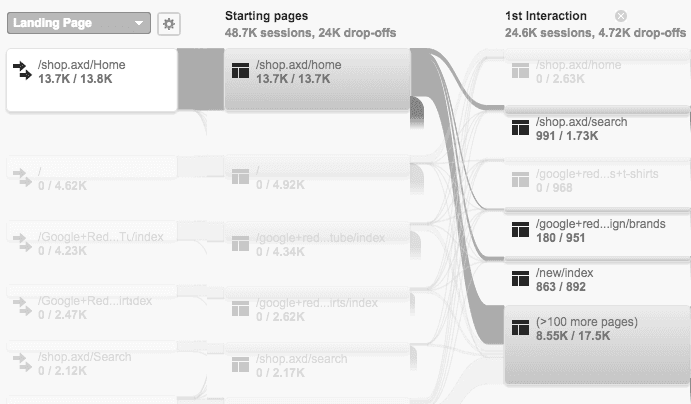
You can use this information to identify the most common user flow and then analyze each page involved to uncover opportunities for optimization. Tools such as heatmap, scrollmap, and session recording can be employed to identify and improve underperforming elements.
Improving Conversions
Conversion is the desired action that you expect from a customer. Depending upon the sales funnel stage, the meaning of conversion changes. Consequently, the metrics to monitor conversion also differ. Below are the metrics to track conversion and strategies to enhance it for each sales funnel stage.
a. Top of the funnel
Metrics: Bounce rate, unique page visits, time spent, pages per session
The first step is to track these metrics using analytics tools. If you have traffic from multiple touch points like search ads and websites, then it’s better to use a tool that integrates data and showcases metrics on a single dashboard. This approach is similar for all sales funnel stages.
In case the analysis reveals underperforming metrics, it is important to check critical factors like website load speed and interactivity time, as customers expect a quick and efficient experience when visiting your website.
Tools like scrollmaps can help determine the point up to which 50% of users scroll before leaving. Additionally, behavior analysis tools such as heatmaps and session recordings can provide insight into the landing page experience. It’s essential to evaluate the complete page experience and performance of all CTAs to identify weak points. Once you’ve pinpointed the issues, you can proceed with the optimization process as previously explained.
b. Middle of the funnel
Metrics: Form completion, CTR of add-to-cart or main CTA button,
If your main calls-to-action (CTAs) are not performing well, it could be due to issues with UI/UX, content placement before the CTA, or the CTA’s positioning, among other factors. To gain insights into why users may be seeing the CTA but not clicking on it and exiting, utilize tools like heatmaps, scrollmaps, and session recordings. This data can then be used to create hypotheses related to design, content (such as headings and text), and the CTA itself (color, text, position), which can be tested in future campaigns.
One method of behavior analysis to test form performance is form analysis. By analyzing the form for hesitation time, dead clicks, and overlooked tabs, you can gain a better understanding of the user experience. Once you have this information and understand the associated clicks, you can create hypotheses for an optimization campaign.
c. Bottom of the funnel
Metrics: CTR of checkout buttons or payment, no. of transactions per user/re-subscription rate, average order value, reviews.
If there is a low click rate for checkout or payment buttons, there could be various causes, such as limited payment options or unfavorable pricing. Behavior analysis or reaching out to users through surveys and emails can help identify the root cause.
Returning customers is valuable for businesses as they reduce customer acquisition costs. Tracking the number of transactions per user can highlight performance issues such as a poor post-purchase experience or subpar customer support. Custom surveys and personalized email campaigns can be used to uncover the root cause, and optimization efforts can focus on personalized experiences or one-touch contact support.
Average order value depends on product recommendations and add-ons. Behavior analysis can assess the performance of these sections, and revamping the product recommendation section through personalization campaigns based on past purchases and interests can improve metrics. For larger websites, server-side testing is recommended for more complex experimentation, such as testing product recommendation algorithms.
Tying it Together
Optimization starts with doing extensive research on what is currently going on with your ads or website, succeeding with building a hypothesis, running a campaign, and tracking improvement in key metrics and learnings of future optimization.
It’s also important to know that running optimization campaigns for search ads and websites in tandem can give a holistic approach to your efforts. Like, the increase in bounce rate for search ads could be due to the slow page loading speed of the landing page. The problems get identified easily, which is difficult when optimization efforts take place in silos for different channels.
In the end, it is essential to highlight that a successful optimization campaign heavily relies on an analytics tool that enables effortless integration of data from different sources. This tool should perform the tedious task of filtering and sorting data, making it easy to read and share essential metrics and other relevant campaign data. Therefore, it is imperative to have a reliable and powerful tool in place before embarking on any optimization campaign, one that can handle and display data with precision and meet all your needs.

Ketan Pande works as a Content Marketer at VWO, a world-leading experimentation platform. His writing primarily revolves around online experimentation, marketing trends, and conversion optimization. Apart from his professional pursuits, Ketan has a keen interest in nature and wildlife, often storytelling facts about them. He is an avid outdoor enthusiast and enjoys leisure like trekking, camping, and birdwatching.

